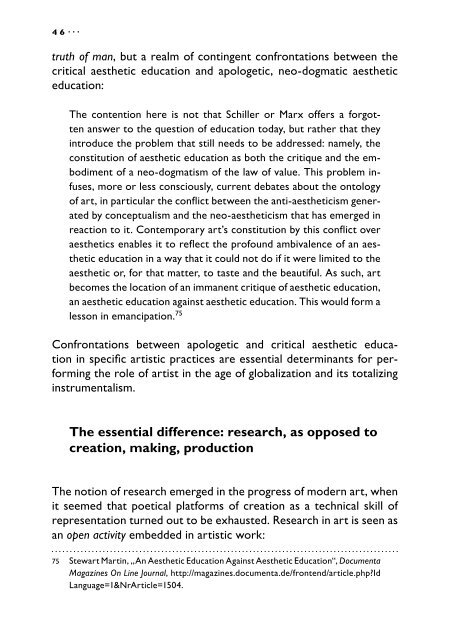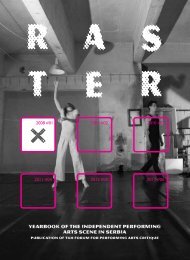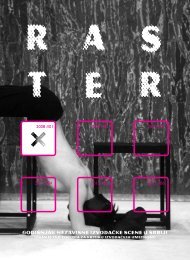Miško Šuvaković Epistemology of Art - TkH
Miško Šuvaković Epistemology of Art - TkH
Miško Šuvaković Epistemology of Art - TkH
You also want an ePaper? Increase the reach of your titles
YUMPU automatically turns print PDFs into web optimized ePapers that Google loves.
46··· ··· 47<br />
truth <strong>of</strong> man, but a realm <strong>of</strong> contingent confrontations between the<br />
critical aesthetic education and apologetic, neo-dogmatic aesthetic<br />
education:<br />
The contention here is not that Schiller or Marx <strong>of</strong>fers a forgotten<br />
answer to the question <strong>of</strong> education today, but rather that they<br />
introduce the problem that still needs to be addressed: namely, the<br />
constitution <strong>of</strong> aesthetic education as both the critique and the embodiment<br />
<strong>of</strong> a neo-dogmatism <strong>of</strong> the law <strong>of</strong> value. This problem infuses,<br />
more or less consciously, current debates about the ontology<br />
<strong>of</strong> art, in particular the conflict between the anti-aestheticism generated<br />
by conceptualism and the neo-aestheticism that has emerged in<br />
reaction to it. Contemporary art’s constitution by this conflict over<br />
aesthetics enables it to reflect the pr<strong>of</strong>ound ambivalence <strong>of</strong> an aesthetic<br />
education in a way that it could not do if it were limited to the<br />
aesthetic or, for that matter, to taste and the beautiful. As such, art<br />
becomes the location <strong>of</strong> an immanent critique <strong>of</strong> aesthetic education,<br />
an aesthetic education against aesthetic education. This would form a<br />
lesson in emancipation. 75<br />
Confrontations between apologetic and critical aesthetic education<br />
in specific artistic practices are essential determinants for performing<br />
the role <strong>of</strong> artist in the age <strong>of</strong> globalization and its totalizing<br />
instrumentalism.<br />
The essential difference: research, as opposed to<br />
creation, making, production<br />
The notion <strong>of</strong> research emerged in the progress <strong>of</strong> modern art, when<br />
it seemed that poetical platforms <strong>of</strong> creation as a technical skill <strong>of</strong><br />
representation turned out to be exhausted. Research in art is seen as<br />
an open activity embedded in artistic work:<br />
75 Stewart Martin, „An Aesthetic Education Against Aesthetic Education“, Documenta<br />
Magazines On Line Journal, http://magazines.documenta.de/frontend/article.php?Id<br />
Language=1&Nr<strong>Art</strong>icle=1504.<br />
The crucial difference between research art and non-research art, it<br />
seems, hence relies on the fact that non-research art starts from set<br />
values, while research art strives to determine values and itself as a<br />
value. Certainly, simultaneously with setting up the art as research,<br />
and self-research as such, the first aesthetics emerges, addressing<br />
the problem <strong>of</strong> art as such, and its place among the works <strong>of</strong> the<br />
spirit. 76<br />
The artist is an active agency, and the framework <strong>of</strong> his work is consciously<br />
determined, though all stages in his actions, i.e. research,<br />
can not be predicted: he encounters discoveries and choices <strong>of</strong> new<br />
domains <strong>of</strong> work. Research in art is <strong>of</strong>ten conceived as a heuristic<br />
procedure. Heuristics is self-motivated research performed, in lack<br />
<strong>of</strong> precise programs or algorithms, from case to case by way <strong>of</strong> a<br />
method <strong>of</strong> trial and error. Therefore, what we term ‘heuristics’ is a<br />
research principle or research <strong>of</strong> research, implying a creative program.<br />
Heuristic research is a research in totality <strong>of</strong> considerations<br />
and procedures <strong>of</strong> searching and finding new, that is, authentic, insights<br />
and contingencies <strong>of</strong> producing an art work. Heuristic research<br />
considers possibilities <strong>of</strong> failure or error, falsity, mistakes and omissions<br />
in advance. The path <strong>of</strong> heuristic research is not grounded on<br />
a system <strong>of</strong> rules, but on disclosure, affirmation, or disposal <strong>of</strong> the<br />
accomplished. Thus is art redirected from ‘creating a work <strong>of</strong> art’,<br />
as setting up the work in the world, to indeterminate research, or a<br />
quest leading to the unknown and unexpected – authentic and new –<br />
while employing both traditional or new media and human relations<br />
established by way <strong>of</strong> art. Research implies a shift from creation <strong>of</strong><br />
the work <strong>of</strong> art (techne + poesis) to an art project. In other words, in<br />
pedagogic procedures the ‘artist’ is not trained to become a creator<br />
(master, craftsman, manufacturer) or even producer, 77 but to become<br />
an author 78 . In this context, the author is an enterpreneur. He<br />
76 G.C. Argan, „Umjetnost kao istraživanje“, from Studije o modernoj umetnosti, Nolit,<br />
Belgrade, 1982, pp. 154.<br />
77 Walter Benjamin, „The Author as Producer“, from Charles Harrison, Paul Wood<br />
(eds), <strong>Art</strong> in Theory 1900-2000 / An Anthology <strong>of</strong> Changing Ideas, Blackwell Publishing,<br />
Oxford, 2003, pp. 493-499; and <strong>Art</strong>&Language, „Author and Producer – Revisited“,<br />
<strong>Art</strong>-Language, vol. 5 No. 1, England, 1982, pp. 22-31.<br />
78 Roland Barthes, „The Death <strong>of</strong> the Author“, from Image Music Text, Hill and Wang,







